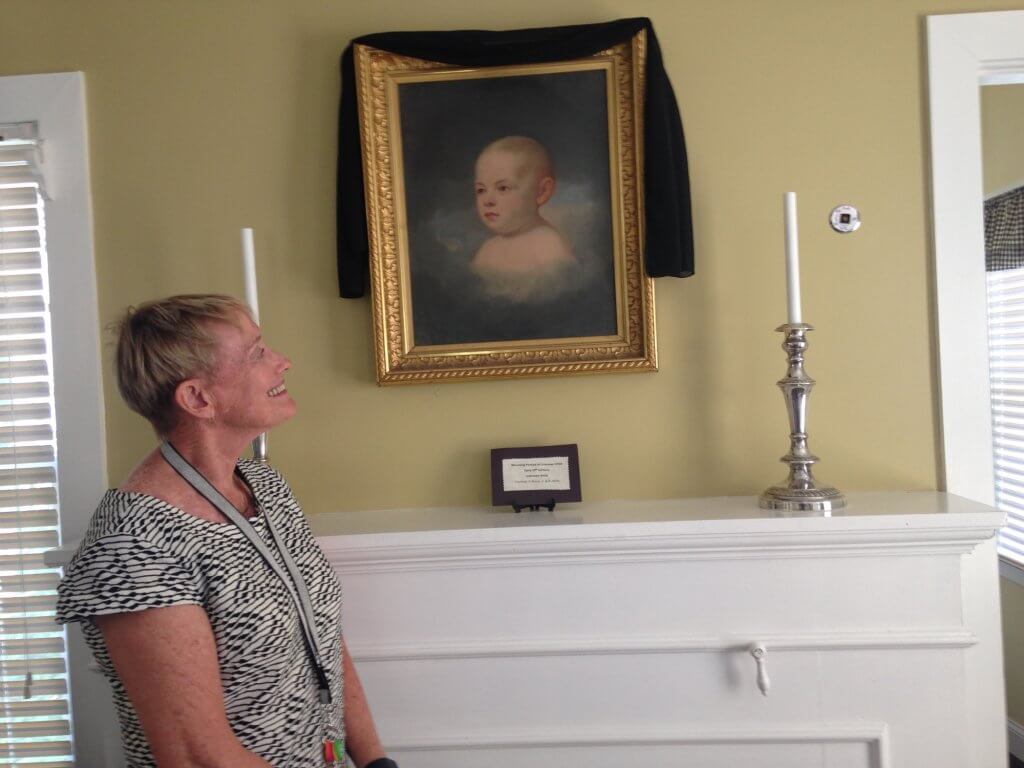SWAINTON – Family portraits draped in black crape cover their faces. A painting of a long-gone baby emerges from the clouds, gaze steady and resolute to the afterlife. The rather sinister tools of the mortuary arts, and dark-colored bracelets and necklaces that, upon closer look, are revealed to be plaited out of human hair.
The Cape May County Historical Museum, after much hard work, has opened the doors to its multi-faceted exhibit of Victorian death and mourning customs, entitled “Forget Me Not: The Final Farewell.”
The exhibit is guest curated by Dr. E. Susanna Eisenhower-Turner, a psychiatrist retired from practice in Media, Pa. and who grew up in the county. The objects and their explanation placards she prepared are exceptionally evocative of an age much associated with this region. “My father was a physician in the county and my grandfather, a pharmacist here, and as a kind of remembrance of them, we’ll be having speakers on 19th-century medicine and pharmaceutical medicine as well as African-American traditions along with Roman Catholic, Jewish and Protestant traditions, she said.
“I really feel this exhibit will have great resonance for our residents and visitors. Most of the items on display have been lent to the museum for the exhibit by collectors and even by people who have lived and worked in the county. Many have never before been displayed. For example, Radzieta Funeral home loaned us the black velvet mourning cloth that drapes the coffin in the parlor of the Museum that we have staged to show a typical Victorian wake,” commented Eisenhower-Turner.
The Victorian Era, named after Queen Victoria who was born in 1819 and reigned over the British Empire from 1837-1901, was marked by distinctive architecture, art, literature and poetry, standards of morality and social customs.
An important element of Victorian times, including in Cape May County, that reflected a unique and in some senses, a macabre system of beliefs was this theme of death and mourning.
The passing of Albert, Victoria’s beloved consort, and husband, plunged the Queen into very deep mourning. Many of those mourning customs, in America as represented by Mary Todd Lincoln, such as unadorned black clothing, self-imposed seclusion, and a romanticized view of death, the afterlife and talking with spirits are closely linked to that era. There were even recipe books for special funeral cakes and cookies served to attending mourners, all with the aim of sending off the departed through a “proper burial” to show respect.
Both those highly recognized figures, the Queen and the First Lady, represented the epitome of Victorian era widows who were designated as the “vessel of mourning” for a family’s grief.
Paradoxically, widowers were only required to wear a black armband and tie and then were expected to quickly resume work and their normal routine.
While Victoria took her mourning to the extreme of never relinquishing her black garb even until her death, traditionally a widow observed three stages of mourning which encompassed at least two years.
The first stage was “deep mourning” and lasted three months during which the widow was required to wear a veil that completely covered her face and was only to be seen in church.
The second stage was “full mourning” and lasted for nine months with the widow adding a bit of white at her cuffs and collar and pinned the veil away from her face as she made limited social visits.
After the first year, the widow entered a “half-mourning” stage as she introduced clothing colors of violet, gray or white and carefully considered the propriety of re-entering society.
“Forget Me Not: The Final Goodbye” showcases the Victorian process of mourning in all its aspects and runs from Sept. 19 through Nov. 12. Along with the gallery display of related artifacts, the museum facility plays a part in the presentation of the exhibit by tangibly showing a Victorian house clothed in mourning including re-enactors, organ music, and wakes.
Museum director, Donna Matalucci, stated, “This exhibit is one of the most ambitious projects we have ever presented.”
Eisenhower-Turner added, “Death was a very common occurrence in the 19th century with the epoch’s many wars, lack of medical knowledge about diseases and sanitation problems. When you look at family Bibles from the time, often there were deaths recorded one after the other in a short period, and many of the deceased were very young.
“At the same time, people were acquiring more possessions through economic prosperity after the Industrial Age and mourning departed family members through these elaborate customs provided social stability and even status.
“Many of the superstitions we still practice today, or even games we play, are rooted in Victorian practices. Covering your mouth when you yawned or throwing spilled salt over your shoulder was to keep the devil away, and the Ouija board and Tarot cards were very popular at the time to connect with loved ones in the afterlife.”
Visit the museum’s website for details on hours for scheduled lectures and other activities that will further bring this exhibit to “life:” www.cmcmuseum.org.
To contact Camille Sailer, email csailer@cmcherald.com.








